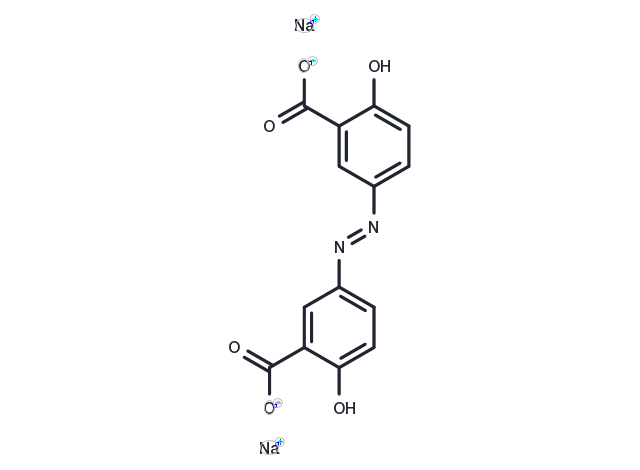Powder: -20°C for 3 years | In solvent: -80°C for 1 year


Olsalazine disodium (Dipentum) is bioconverted to 5-aminosalicylic acid (5-ASA) in the colon and has anti-inflammatory activity in ulcerative colitis.

| Pack Size | Availability | Price/USD | Quantity |
|---|---|---|---|
| 500 mg | In stock | $ 45.00 | |
| 1 mL * 10 mM (in DMSO) | In stock | $ 50.00 |



| Description | Olsalazine disodium (Dipentum) is bioconverted to 5-aminosalicylic acid (5-ASA) in the colon and has anti-inflammatory activity in ulcerative colitis. |
| Targets&IC50 | Chemotaxis to LTB4 (human intestinal macrophages):0.39 mM |
| In vitro | In nu/nu CD-1 mice with experimental colitis induced by sodium dextran sulfate, daily treatment with Olsalazine (50 mg/kg) led to the bacterial azoreductase cleavage of azo bonds, releasing mesalazine, which is capable of treating colitis. |
| In vivo | In isolated rat ileal and guinea pig ileal mucosa, Olsalazine (less than 2.89 mM) increases the secretion of sodium and chloride ions, while decreasing the absorption of chloride ions. In isolated rat colonic tissues, Olsalazine (less than 11.5 mM) reduces net sodium levels and chloride ion absorption in a dose-dependent manner, and at high concentrations (11.5 mM), it increases potassium secretion. Moreover, in isolated rat jejunum, Olsalazine inhibits the absorption of glucose and lactose. In human intestinal macrophages (IC50=0.39 mM), Olsalazine acts as an effective inhibitor of the chemotaxis of LTB4. |
| Synonyms | Dipentum, Olsalazine Sodium |
| Molecular Weight | 346.2 |
| Formula | C14H8N2Na2O6 |
| CAS No. | 6054-98-4 |
Powder: -20°C for 3 years | In solvent: -80°C for 1 year
H2O: 38 mg/mL (109.8 mM)
DMSO: 4 mg/mL (11.55 mM)
Ethanol: < 1 mg/mL (insoluble or slightly soluble)
You can also refer to dose conversion for different animals. More
bottom
Please see Inhibitor Handling Instructions for more frequently ask questions. Topics include: how to prepare stock solutions, how to store products, and cautions on cell-based assays & animal experiments, etc.
Olsalazine disodium 6054-98-4 Immunology/Inflammation Microbiology/Virology Neuroscience Others COX Antibiotic Antibacterial Dipentum Olsalazine Bacterial inhibit Inhibitor Olsalazine Sodium inhibitor
